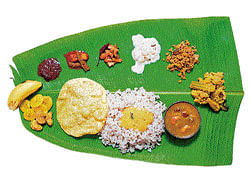Feasting on food stories

I met her outside a mithai shop in Navi Mumbai. I didn’t know doctors of Ayurveda also wore the proverbial white coat. We were complete strangers, but it didn’t seem to bother either of us as we settled into the back seat of the cab and started talking food.
“I am a typical Tam Bram girl married to a Malayali Christian brought up in Bombay,” said Rupa Laxminarayan. Which is not such an uncommon story these days. “I connected with my father’s sister, who is married to someone from Alleppey. The food there is hard core and traditional,” she added by way of introduction.
The words ‘hard core’ sounded a little too strong to me but as she went on, I began to understand what she meant. “For the coffee decoction, my aunt gets a bucket of water from the centre of the well. She believes that her filter coffee gets its special taste because of this water. If, for some reason, she has to use municipality water, she won’t use it fresh since it will have the smell of chlorine. She’ll stay thirsty for a couple of hours, keep the water in the sunlight and wait for the smell of chlorine to go!”
“Charming,” I muttered to myself.
Live to eat
Rupa continued, “The red poha we use comes from parboiled rice. It is not washed; just cleaned by hand and hand- crushed. We add three-fourths of a fresh coconut, grated; a half portion of grated jaggery and some elaichi powder to the poha. And we show no mercy while crushing it! This dish stays in my memory as one of the most delicious snacks I’ve ever eaten,” she says.
Alleppey is fertile and everything that was cooked in Rupa’s aunt’s house, I’m told, was brought in straight from the backyard.
“That household’s life revolved around food: what will be cooked and how will it be made were ruling concerns. Now my aunt’s way of life is my way of life. I am already thinking of lunch for the next three days,” said Rupa with a chuckle.
In Kerala Bhavan for a working lunch, Rupa and I ate our way through Kerala sambhar, parboiled rice, beetroot toran, and mazhuku paratii. Mazhuku means oil, paratii means ‘apply’ or ‘spread’. The name of the dish simply means ‘stir-fried’, and the key ingredient is coconut oil. Sometimes, it’s also made with French beans, yam or raw bananas. It’s a simple dish, just stir-fried in salt and haldi and little else, and it is cooked slowly on firewood for an hour. It had a brilliant flavour and a nice crunchiness. Along with this was moru curry (moru means buttermilk), to which coconut paste is added along with jeera and green chillies. It is tempered with mustard seeds, urad dal, fenugreek seeds and red chillies in coconut oil.
“At home, we use a simple set of masalas. We call them the 3Ms — malli, which is dry coriander; manjal, which is turmeric or haldi; and molagai, which is chillies. We marinate fish in this masala and we make our curries also with this masala as the base,” explained Rupa.
She observed that such essential elements of food culture were in danger of fading away from the memory of those whose lives have been taken over by supermarkets and processed foods.
“As a young girl, I lived in a large joint family. We had lots of people at home and lots of food was constantly cooked. I spent all my summers in Kerala. A lot of food used to get cooked on firewood, and most of the ingredients came from in and around the house. In summer, typically, every meal had mango — raw or ripe, and jackfruit, and everything was slow cooked. You don’t see that happening anymore.
“When you get up in the morning in Kerala, you put the tur dal to cook and go for a bath. And when you come back after one-and-a-half hours, it’s done to perfection! The amount of time given to the dal to cook is what makes the flavour so different. Like the kaali dal that is left to cook overnight. Now if you zap it in a microwave oven for a few seconds like they do on TV shows, god help you!”
Rupa has little sympathy for the zappers! “Indian cooking is not done on high heat. Our food has always been slow-cooked on a chulha and firewood.”
Simple dishes like upma kozhakattai, which is made from rice flour, send her into raptures. Sharing the recipe, she says the rice is soaked, dried, coarsely ground and cooked, like upma. It is then steamed in small balls and served with a theeka (spicy) chutney. “It’s a very simple dish, but no one serves it because it’s not sold readymade,” she quipped.
There is also thanni (water) kozhakattai. To make this, parboiled rice is soaked and coarsely ground. Fresh, grated coconut is added to this along with salt and jeera. The mixture is formed into one-inch balls and added to boiling water. The balls are cooked when they float to the surface and the liquid assumes a gooey texture, loaded with the flavour of jeera.
This dish is eaten with a simple chutney made with red chillies roasted on a tawa, rock salt and a little tamarind. The ingredients are crushed coarsely by hand. A little coconut oil is poured on top to finish the chutney.
“There is a logic to ingredients used in Indian cuisine. Apart of adding flavour, every ingredient has a specific role to perform. When we take short cuts, we lose out both on taste and a deconstructed way of life,” she said, and I couldn’t but agree with her.
Deccan Herald is on WhatsApp Channels| Join now for Breaking News & Editor's Picks